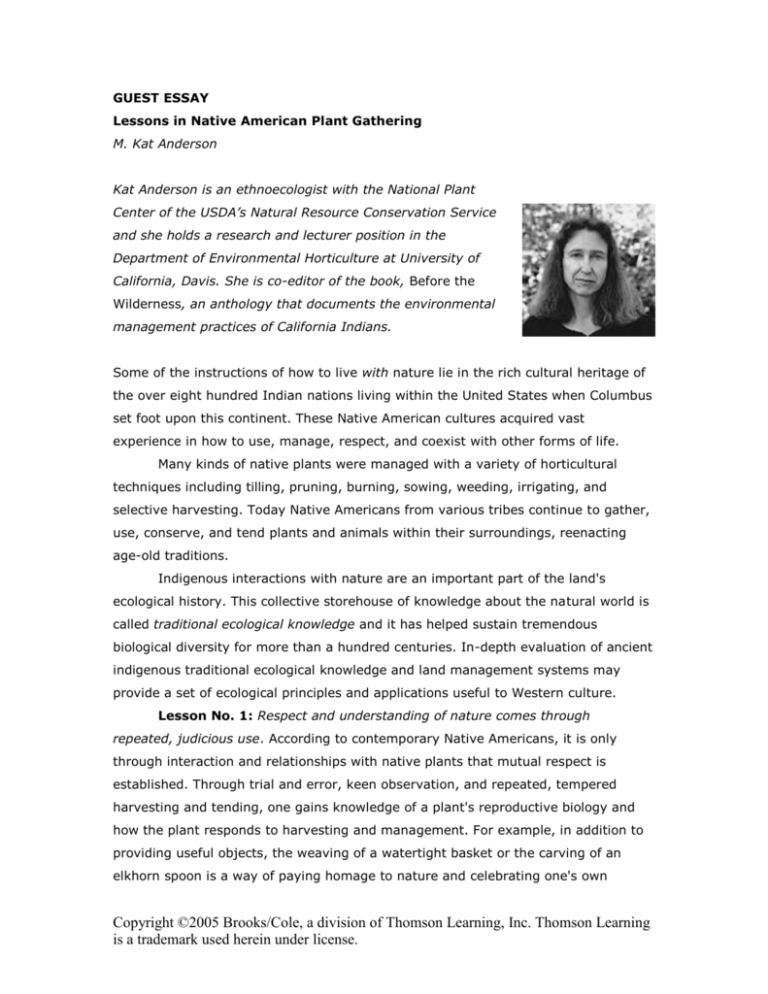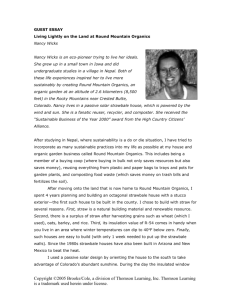Lessons in Native American Plant Gathering, M
advertisement

GUEST ESSAY Lessons in Native American Plant Gathering M. Kat Anderson Kat Anderson is an ethnoecologist with the National Plant Center of the USDA’s Natural Resource Conservation Service and she holds a research and lecturer position in the Department of Environmental Horticulture at University of California, Davis. She is co-editor of the book, Before the Wilderness, an anthology that documents the environmental management practices of California Indians. Some of the instructions of how to live with nature lie in the rich cultural heritage of the over eight hundred Indian nations living within the United States when Columbus set foot upon this continent. These Native American cultures acquired vast experience in how to use, manage, respect, and coexist with other forms of life. Many kinds of native plants were managed with a variety of horticultural techniques including tilling, pruning, burning, sowing, weeding, irrigating, and selective harvesting. Today Native Americans from various tribes continue to gather, use, conserve, and tend plants and animals within their surroundings, reenacting age-old traditions. Indigenous interactions with nature are an important part of the land's ecological history. This collective storehouse of knowledge about the natural world is called traditional ecological knowledge and it has helped sustain tremendous biological diversity for more than a hundred centuries. In-depth evaluation of ancient indigenous traditional ecological knowledge and land management systems may provide a set of ecological principles and applications useful to Western culture. Lesson No. 1: Respect and understanding of nature comes through repeated, judicious use. According to contemporary Native Americans, it is only through interaction and relationships with native plants that mutual respect is established. Through trial and error, keen observation, and repeated, tempered harvesting and tending, one gains knowledge of a plant's reproductive biology and how the plant responds to harvesting and management. For example, in addition to providing useful objects, the weaving of a watertight basket or the carving of an elkhorn spoon is a way of paying homage to nature and celebrating one's own Copyright ©2005 Brooks/Cole, a division of Thomson Learning, Inc. Thomson Learning is a trademark used herein under license. humanness. If the same shrub or tree is harvested for many generations, it is also a way of connecting humans with their past. A healthy six hundred-year-old tree, four hundred-year-old shrub, or century old fern is living proof that harvesting with restraint and temperance is respectful of the natural world. Lesson No.2: The rate of harvesting should not exceed the biological capacity of plant populations to regenerate. Many Native American cultures gathered renewable plant parts in the form of fruits, branches, leaves, flowers, corms, and stems year after year, while leaving individual plants and plant parts behind to ensure plant replacement. For example, in what is present-day New York, the Seneca, after gathering herbaceous plants, would break off the seed stalks and drop the pods into dug holes along with a handful of leaf mold. After the Potawatomi gathered the roots of plants for medicines, they placed the seed heads in the holes from which they removed the roots and covered them back up. When digging the Dena'ina of Alaska purposefully left fragments of underground swollen stems in the soil to insure the growth of new plants. Lesson No. 3: Help insure the future abundance of native plants by gathering, pruning, or burning them at certain seasons of the year. The time of year a plant is harvested affects its long-term productivity. Tribes of the Rocky Mountain region harvested large quantities of the prairie turnip when the tops were browning in July or August only after the plants had reseeded a site. California Indian basket weavers still prune or burn native shrubs such as sourberry, buckbrush, and redbud in the fall or winter after the leaves have dropped, a time that is least detrimental to the vital processes of such plants. Lesson No. 4: Regulate the frequency of harvest to enable plant and animal regeneration. The Cree rotate their animal traplines every year, allowing 4-year rest periods to reduce the possibility of overhunting. A 3-year rest period was specified for the gathering of western red cedar roots among the Klikitat basket makers of southern Washington. Navajo medicine men still refrain from harvesting plants from the same stand two years running. Lesson No. 5: Set fires to help maintain specific vegetation types and increase ecological biodiversity. Many habitats were deliberately maintained by, and essentially dependent upon, ongoing Indian-set fires. In the Pacific Northwest, prairies were burned to keep them open and increase the yields of camas and bracken fern rhizomes eaten by various tribes in western Washington. In the Sierra Nevada of California, Native Americans used repeated burning to influence the size of Copyright ©2005 Brooks/Cole, a division of Thomson Learning, Inc. Thomson Learning is a trademark used herein under license. black oak-ponderosa pine forests and montane meadows. Within the boreal forest of Alberta, Canada, Slavey, Cree, and Beaver Indians regularly burned meadows to keep them from being taken over by brush and forest. In the Southwest, fires were set by the Shoshone to favor native grass seeds and prevent invasion by surrounding woody vegetation. Some Native American cultures used fire to create or enhance ecological effects such as (1) the recycling of nutrients, (2) decreasing plant competition, (3) increasing the abundance, density, and diversity of plant species, (4) augmenting seed, fruit, or bulb production, (5) increasing the quality and quantity of forage for wildlife, (6) reducing insect infestations and diseases, (7) reducing catastrophic fires, and (8) decreasing detritus (dead and rotting material). These valuable ecological lessons and more detailed experimental research can help Western society use nature in ways that maintain a diversity of wild plant and animal genetic resources and preserve the renewal capacity of the land. Renewed respect for Native American ecological wisdom may also promote efforts to restore traditional land and resource rights to indigenous peoples. Critical Thinking Find a nearby area of land and use the principles in this essay to develop a plan for its use and management. Present the plan to the owners of the land. Copyright ©2005 Brooks/Cole, a division of Thomson Learning, Inc. Thomson Learning is a trademark used herein under license.











